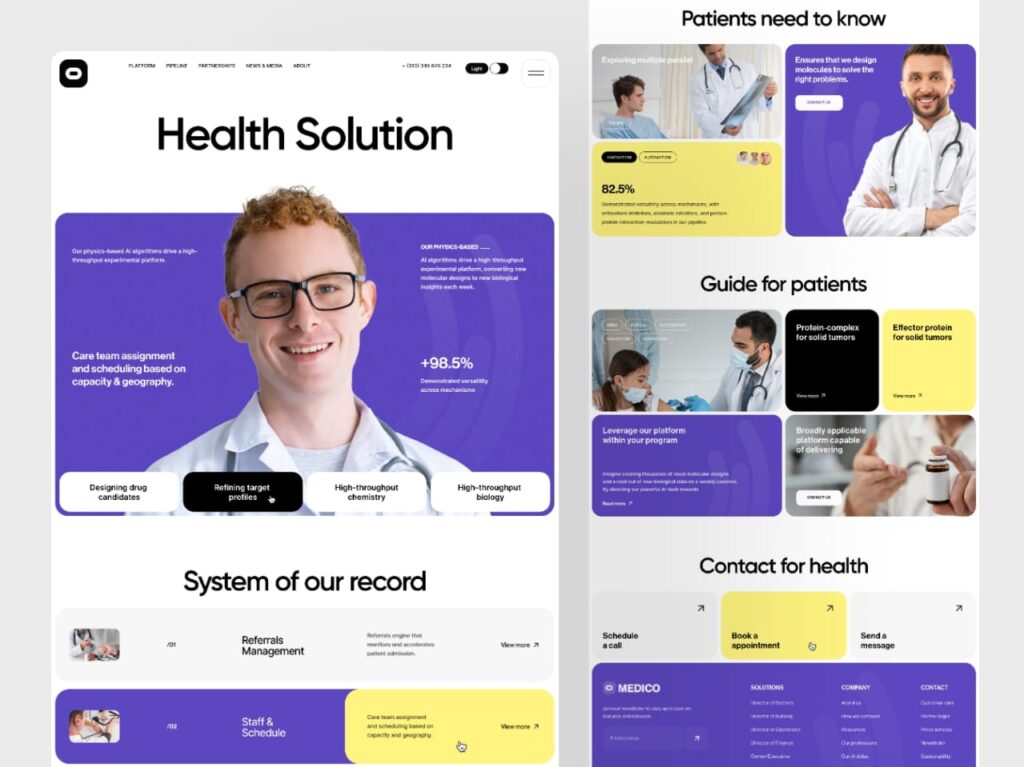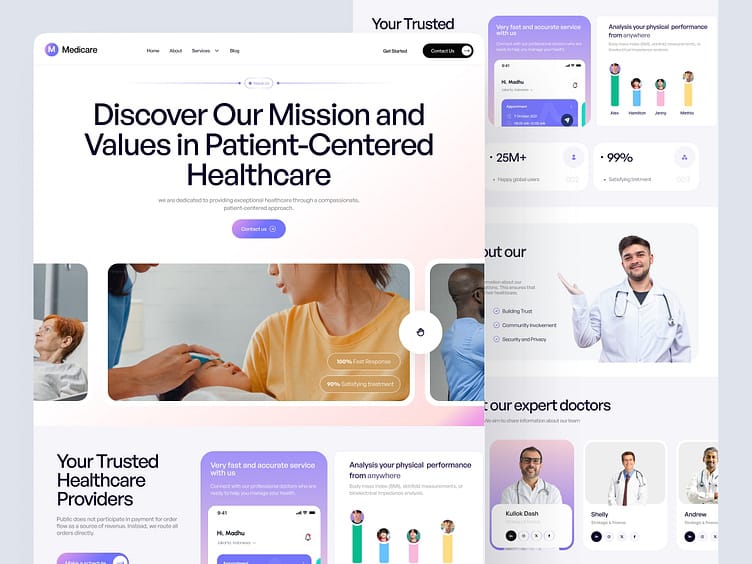
Having a professional, secure, and user-friendly website is no longer optional for healthcare providers; it’s an absolute necessity in today’s digital world.
Custom healthcare website design involves creating a site from scratch or significantly adapting existing frameworks to perfectly address the unique needs of patients, clinics, hospitals, or large healthcare systems. This approach moves far beyond basic, off-the-shelf templates, ensuring the site meets specific operational and patient-facing goals.
Chicago presents a particularly compelling market for this kind of specialised web design. First, the city’s large size and remarkable diversity demand robust, accessible digital solutions. Furthermore, Chicago is home to a high concentration of major health institutions, including leading hospitals, prominent medical schools, and various speciality clinics.
Consequently, patients in this competitive metropolitan area hold high expectations for digital services. They require sites that deliver performance, clarity, security, and effortless mobile access. They also look for multilingual content and a modern user experience (UX). Ultimately, the regulatory scrutiny inherent in a major health hub like Chicago necessitates a secure and compliant design from the outset.
Why Chicago Healthcare Providers Need Custom Website Design

In Chicago’s competitive healthcare landscape, a custom-designed website is essential for success. It addresses key needs from building patient trust to achieving local visibility and supporting future growth.
Building trust and credibility
Healthcare is a deeply personal and sensitive field. Patients must feel confident that their chosen provider is competent, professional, and trustworthy. A custom design is crucial because it allows providers to effectively showcase doctor credentials, certifications, patient testimonials, and robust privacy policies. Furthermore, it enables the creation of secure, branded contact points, presenting a polished and cohesive brand identity that immediately instils confidence in potential patients.
Differentiating in a crowded market
Chicago’s metropolitan area is saturated with clinics, large health systems, and speciality practices—most of which already maintain a web presence. A custom-built site enables a provider to stand out visually, functionally, and through a superior patient experience. For example, a speciality practice such as orthopaedics, dermatology, or behavioural health can tailor its branding and navigation to reflect its specific focus. A generic template cannot achieve this.
Delivering tailored functionality
Standard website templates frequently lack the sophistication required for specialised healthcare operations. Custom design ensures the website can seamlessly integrate and manage critical features. Providers can build sophisticated tools such as patient portals, real-time appointment scheduling, telehealth platforms, secure intake/consent forms, and direct integration with Electronic Health Records (EHR) and insurance billing systems, guaranteeing these functions work smoothly and securely.
Maximising SEO and local visibility
For Chicago patients searching for local care, visibility on Google is paramount. Google’s algorithms heavily favour factors like mobile-friendliness, site speed, and secure connections (HTTPS), all of which a custom site optimises. Crucially, optimising for local SEO requires custom content and structured data tailored to Chicago’s specific search patterns. Patients frequently use neighbourhood names or ZIP codes (e.g., “Hyde Park urgent care,” “Lincoln Park dentist”), and a custom approach ensures the site effectively captures these high-intent local queries.
Ensuring long-term maintainability and scalability
A custom-architected website provides a solid foundation for future growth and adaptation. As a practice expands services, regulatory requirements evolve, or telehealth becomes a larger focus, the site can easily update and expand without a significant overhaul. This approach ensures the provider avoids the typical constraints of template limitations or disruptive plugin conflicts, offering long-term stability and easier maintenance.
Compliance and Regulation for U.S. Healthcare Websites: Chicago and Illinois
Designing and developing a healthcare website requires navigating a complex landscape of regulatory and compliance considerations. Failure to meet these standards can result in more than just a poor user experience—it can lead to significant legal liability, financial fines, and a damaging loss of patient trust.
HIPAA (Health Insurance Portability and Accountability Act)
The Health Insurance Portability and Accountability Act (HIPAA) is paramount. If your website collects, stores, transmits, or handles Protected Health Information (PHI), you must adhere to HIPAA’s rules.
Key Requirements:
- You need secure hosting, robust encryption (for data in transit and at rest), comprehensive audit logging, and strict access controls.
- Forms, appointment scheduling systems, and messaging/telehealth modules must not send PHI to non-secure or non-compliant endpoints. For example, a contact form routing patient data to a general, unsecure email service will likely violate HIPAA.
- Web design and development vendors working with PHI must sign a BAA with the healthcare provider.
ADA, WCAG & Illinois Accessibility Laws
Web accessibility ensures that people with disabilities can use digital services. The core standard for compliance is the Web Content Accessibility Guidelines (WCAG) 2.1 Level AA.
- The Americans with Disabilities Act (ADA) requires that digital services be accessible. While the law’s application to websites continues to evolve legally, healthcare providers’ websites should generally conform to WCAG 2.1 Level AA to mitigate legal risk. The U.S. Department of Justice (DOJ) finalised rules in April 2024, strengthening Title II ADA compliance, now explicitly requiring state and local governments to follow WCAG 2.1 Level AA.
- The Illinois Information Technology Accessibility Act (IITAA) mandates that state governmental entities and universities ensure digital content is accessible. While private healthcare entities may not be directly subject to IITAA, the law signals a clear legal trend. Furthermore, Illinois is aligning its IITAA to match the new federal Title II ADA requirements.
State & Local Illinois Laws
Beyond federal laws, designers must consider Illinois-specific legislation and trends:
- Although some mandates apply more strictly to public agencies, Illinois agencies must provide language assistance services and accessible forms. Private healthcare providers serving diverse patient populations should proactively consider a multilingual design to improve patient care and compliance.
- Bills passed or considered in Illinois (like HB4541) require public websites to be mobile-friendly and accessible. Even though these directly target government sites, they set a public expectation and signal the direction of future legal requirements for all major services.
Security Best Practices
Implement these foundational best practices to protect patient data and maintain compliance:
- Always implement HTTPS/SSL across the entire website.
- Secure hosting requires regular platform, theme, and plugin patching and updating.
- Encrypt data and maintain proper backups.
- Implement strict authentication and session timeouts, particularly for patient portals or telehealth systems.
- Minimise third-party trackers or scripts that could inadvertently leak data. Studies show many Illinois hospital websites use multiple web trackers, increasing risk.
Privacy & Data Protection
- Provide clear privacy policies and cookie notices.
- Obtain explicit consent for data collection.
- Confirm that all third-party integrations (e.g., analytics, scheduling software, chatbots) are also compliant if they handle or transport any sensitive data.
- Manage PHI according to HIPAA, which may also involve data residency considerations.
Core UX Design & Principles for Effective Healthcare Websites

To create a healthcare website that effectively serves patients, prospective patients, and staff while meeting all regulatory standards, User Experience (UX) and design must be the central focus.
Clear and Intuitive Navigation:
A website’s navigation structure is its backbone. Patients often visit your site when they are under stress or time pressure, so the navigation must be immediately intuitive. Key sections should include:
- About Us: Information on Doctors / Providers, including credentials and photos.
- Services Offered or Specialities.
- Locations and directions.
- Contact Us information.
- Insurance & Billing details.
- Patient Portal / Virtual Visits access.
- FAQs (Frequently Asked Questions).
Prominent Calls-to-Action (CTAs):
Effective CTAs guide users to their next step. Make key actions visible and consistent across the site, ideally positioned above the fold where relevant. Essential CTAs include:
- Book Appointment
- Contact
- Virtual Visit Access
- Patient Portal Login
Mobile-First and Responsive Design:
Since many patients use mobile devices to search for information while at home or on the go, the site must deliver an excellent experience on small screens. Prioritise speed and readability to ensure the site performs well, regardless of the device.
Readable Typography and Calming Colour Palettes:
The visual design should promote ease and trust. Use ample white space and avoid harsh colours or overly busy layouts.
- Select fonts that are large enough and pair them with excellent colour contrast. Organise text with headings, subheadings, and bullets to facilitate quick scanning.
- Adopt a professional, calming colour palette that reassures visitors.
Establishing Trust Signals:
Patients need confidence in their healthcare provider. The site should actively display signals that build trust.
- Feature provider bios with clear credentials and professional photos.
- Showcase relevant certifications and security badges.
- Share authentic patient testimonials.
- Ensure the privacy policy is clearly visible and accessible.
- A clean, professional design itself acts as a strong trust signal.
Engaging Visual Content:
Use high-quality visual content to connect with visitors. Whenever possible, use photos of your actual staff and facilities rather than generic stock imagery.
- Consider adding video tours of the facility or patient stories.
- Ensure all visual media includes alt text for accessibility.
- Optimise the size of all images and videos to maintain fast page performance.
Local SEO Usability:
Help prospective local patients find you. Clearly integrate information that improves your Local Search Engine Optimisation (SEO).
- Prominently display location information and map integrations.
- Include neighbourhood references.
- Optimise for your Google My Business profile.
- Integrate frequently searched local terms, such as “orthopaedic surgery in Chicago” or “best paediatrician near me.”
Consistency in Branding and Design:
A unified experience builds familiarity and strengthens trust. Maintain a consistent style across the entire site for all design elements. This includes:
- Headers
- Buttons
- Colour Scheme
- Iconography
- Tone of Copy
Conclusion
Custom website design for healthcare providers in Chicago is more than aesthetic: it’s about meeting high patient expectations, securing sensitive information, complying with legal and regulatory standards, and standing out in a competitive market. Compliance & accessibility are non-negotiable because they affect trust, law risk, and patient satisfaction. Telehealth, appointment scheduling, patient portal, multilingual support, and user-friendly content all matter. Look for experience, local knowledge, client references, ability to deliver compliance, and good communication.